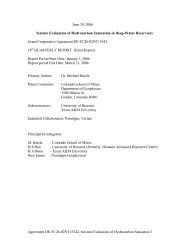Upgrading of Low-Rank Coals - National Energy Technology ...
Upgrading of Low-Rank Coals - National Energy Technology ...
Upgrading of Low-Rank Coals - National Energy Technology ...
You also want an ePaper? Increase the reach of your titles
YUMPU automatically turns print PDFs into web optimized ePapers that Google loves.
Introduction and Executive Summary<br />
The Clean Coal <strong>Technology</strong> (CCT)<br />
Demonstration Program is a government<br />
and industry co-funded effort to demonstrate<br />
a new generation <strong>of</strong> innovative coal<br />
utilization processes in a series <strong>of</strong> “showcase”<br />
facilities built across the country.<br />
These demonstrations are on a scale sufficiently<br />
large to demonstrate commercial<br />
worthiness and to generate data for design,<br />
construction, operation, and technical/<br />
economic evaluation <strong>of</strong> full-scale commercial<br />
applications.<br />
The goal <strong>of</strong> the CCT program is to<br />
furnish the U.S. energy marketplace with<br />
a number <strong>of</strong> advanced, more efficient, and<br />
environmentally responsible coal-utilizing<br />
technologies. These technologies will<br />
mitigate the economic and environmental<br />
impediments that limit the full utilization<br />
<strong>of</strong> coal.<br />
To achieve this goal, beginning in 1985<br />
a multi-phased effort consisting <strong>of</strong> five<br />
separate solicitations was administered by<br />
the U.S. Department <strong>of</strong> <strong>Energy</strong> (DOE).<br />
Projects selected through these solicitations<br />
have demonstrated technology options with<br />
the potential to meet the needs <strong>of</strong> energy<br />
markets and respond to relevant environmental<br />
requirements.<br />
This report discusses two CCT demonstration<br />
projects that involve upgrading <strong>of</strong><br />
low-rank coals. <strong>Low</strong>-rank western coals,<br />
primarily subbituminous and lignite, are<br />
generally low in sulfur, making them very<br />
useful as power plant fuels in place <strong>of</strong> highsulfur<br />
eastern coals. However, there are<br />
disadvantages to low-rank coals, especially<br />
their high moisture content and low heating<br />
value. To overcome these problems, two<br />
upgrading processes have been developed<br />
under the CCT Program: ENCOAL ’ s Liquids<br />
From Coal (LFC ® ) process and Rosebud<br />
SynCoal Partnership’s Advanced Coal<br />
Conversion Process (ACCP).<br />
These projects have been administered<br />
for DOE by its Federal <strong>Energy</strong> <strong>Technology</strong><br />
Center (FETC).<br />
The LFC process involves mild gasification<br />
to produce a dry, solid fuel and a<br />
liquid hydrocarbon fuel. The process has<br />
been demonstrated for about five years at<br />
a test facility near Gillette, Wyoming. At<br />
this plant, which is rated at 1,000 tons/day<br />
<strong>of</strong> coal feed, over 83,000 tons <strong>of</strong> specification<br />
solid fuel product and 4.9 million<br />
gallons <strong>of</strong> liquid product have been produced.<br />
A design and cost estimate have been<br />
prepared for a commercial plant processing<br />
6,000,000 tons/yr <strong>of</strong> raw coal at Triton<br />
Coal Company’s North Rochelle mine.<br />
The ACCP involves thermal upgrading<br />
with hot combustion gas, followed by physical<br />
cleaning to separate ash. The process<br />
has been demonstrated at a test facility<br />
near Colstrip, Montana, which also has<br />
operated for about five years. Rated at<br />
1,500 tons/day <strong>of</strong> coal feed, this plant has<br />
processed nearly 1.6 million tons <strong>of</strong> raw<br />
coal, yielding over 1 million tons <strong>of</strong><br />
product coal. A design has been prepared<br />
for a commercial facility to produce<br />
400,000 tons/yr <strong>of</strong> SynCoal to feed<br />
Minnkota’s Milton R. Young power<br />
plant at Center, North Dakota.<br />
Both projects have met their goals <strong>of</strong><br />
successfully demonstrating the upgrading<br />
<strong>of</strong> low-rank coals to significantly reduce<br />
moisture and hence improve heating value.<br />
In common with other processes for removing<br />
moisture from low-rank coals, problems<br />
with product stability have been encountered.<br />
These problems include reabsorption<br />
<strong>of</strong> moisture, formation <strong>of</strong> dust, and spontaneous<br />
combustion. Solutions to these<br />
problems have been developed to meet<br />
market requirements for handling <strong>of</strong> the<br />
products.<br />
1

















